تعد إدارة العلاقات مع العملاء أحد الأهداف العديدة في المبيعات. فأنت تقضي الوقت في بناء الثقة، والتفاعل مع العملاء، وابتكار منتجات وخدمات تجعل حياتهم أفضل.
لكن القيام بهذا العمل ليس كافياً. فأنت بحاجة إلى طرق لجمع وتتبع الرؤى من بيانات المبيعات. وبهذه الطريقة يمكنك معرفة ما هي الحملات التي تحقق النتائج، واكتشاف الاختناقات في العملية، وتحديد أعضاء الفريق الأكثر فعالية. إدارة علاقات العملاء (CRM) تتيح لك التقارير تتبع التفاعلات مع العملاء وإنشاء بيانات مرئية. بالتسلح بهذه المعلومات، ستتمكن من إنشاء بيئة مرنة لأعمالك للتكيف مع احتياجات العملاء.
سنوضح لك هنا ما الذي يستلزمه إعداد تقارير إدارة علاقات العملاء وسبب أهميتها لفريق المبيعات لديك. بالإضافة إلى ذلك، سنستعرض كيفية إنشاء تقرير إدارة علاقات العملاء ومشاركة نماذج وأمثلة لإدارة علاقات العملاء يمكنك استخدامها للإلهام. ✨
ما هو تقرير إدارة علاقات العملاء؟
تأخذ تقارير إدارة علاقات العملاء بيانات المبيعات والعملاء وتحولها إلى مخططات مرئية بهدف تحسين التنبؤ وتحقيق أهداف المبيعات. باستخدام هذه الرؤى، يمكنك اتخاذ قرارات أكثر استنارة بشأن أنواع المنتجات التي تنشئها أو الحملات التسويقية التي تديرها.
هناك عدة أنواع مختلفة من تقارير CRM بناءً على ما تريد تتبعه. ستجد تقارير CRM لأداء العملاء المحتملين, خطوط أنابيب المبيعات وإنتاجية الفريق. بالإضافة إلى ذلك، هناك تقارير لتوقعات الإيرادات وأنشطة المبيعات.
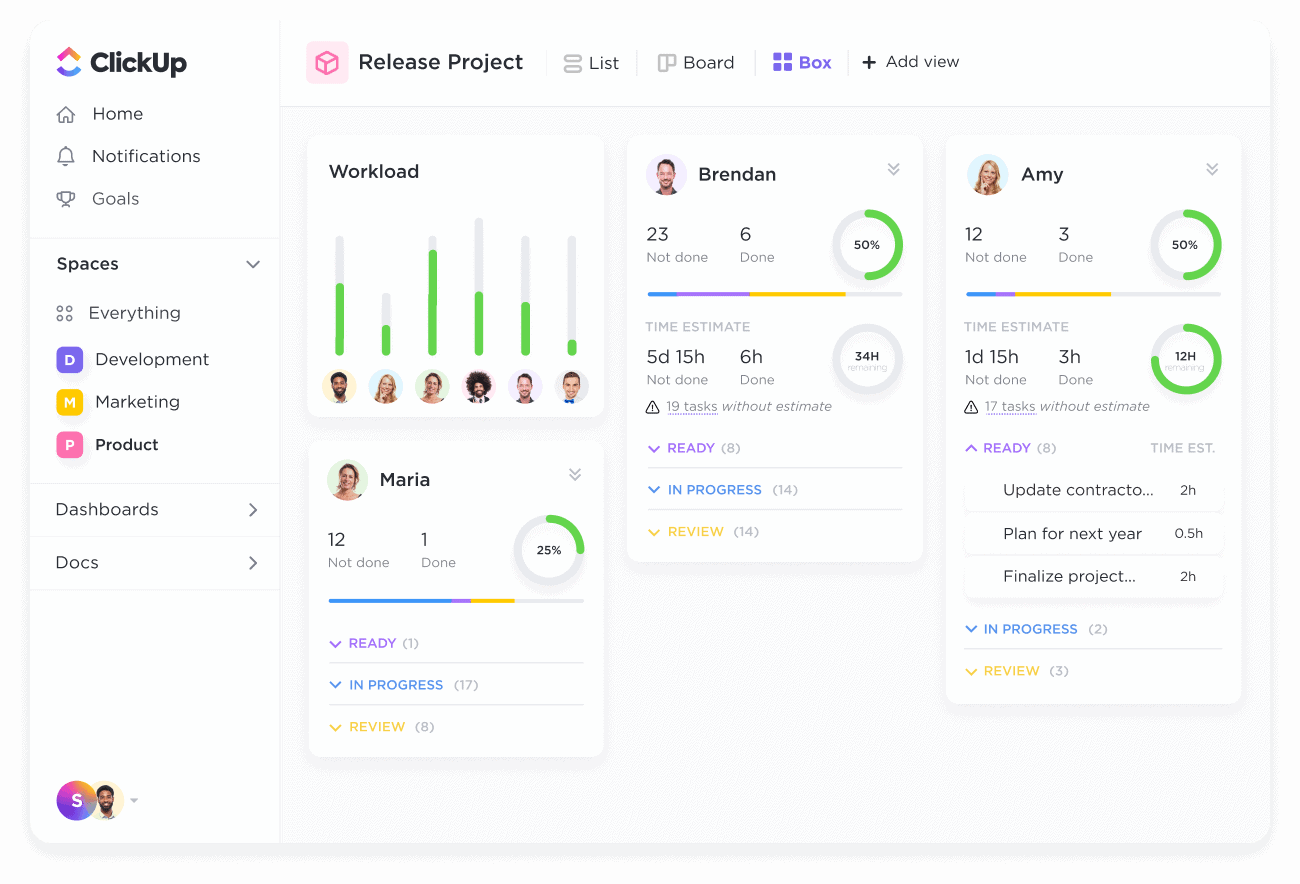
تتيح لك طريقة عرض الفريق رؤية ما يعمل عليه فريقك وما أنجزوه وما هي قدراتهم
ترصد تقارير CRM أيضًا شعور العملاء تجاه حملاتك. ركز على مرحلة معينة من مسار المبيعات باستخدام تقرير خط أنابيب مبيعات CRM الذي يستهدف العملاء. تتبّع أداء الحملة واعرف ما الذي يحقق إيرادات باستخدام تقرير الربحية.
مع وجود الكثير من التنوع، تعد تقارير CRM ضرورية لتخطيط المبيعات ونجاحها. سواء كنت تتبع مدى تفاعل العملاء مع خدمة جديدة أو تريد طرقًا لمعالجة عبء العمل على الفريق، يمكن لتقارير إدارة علاقات العملاء إنجاز المهمة. 💪
لماذا تعتبر تقارير إدارة علاقات العملاء مهمة؟
توفر تقارير إدارة علاقات العملاء رؤى لا يمكنك الحصول عليها في أي مكان آخر. واستنادًا إلى البيانات الفعلية ذات الصلة بشركتك، فإن هذه التقارير مهمة للغاية لتحسين عملياتك وبناء أساليب أفضل للمبيعات. 👩🏽💼
فيما يلي بعض فوائد إعداد تقارير إدارة علاقات العملاء:
- اتخاذ قرارات أفضل: من خلال تحليل البيانات المتعلقة بالمقاييس الرئيسية، يتخذ مندوبو المبيعات قرارات أفضل عندما يتعلق الأمر بتحديد أولويات الحملات ومبادرات المبيعات
- الحصول على رؤى قيّمة: توفر البيانات في الوقت الفعلي إحصائيات أفضل لتوقعات المبيعات وتتيح لمندوبي المبيعات الاستجابة بسرعة أكبر لاحتياجات العملاء من خلال الوصول السريع إلى رؤى قيّمة
- تحسين مشاركة العملاء: تساعدك تقارير البيانات على فهم العملاء وتصرفاتهم بشكل أفضل. وبهذه الطريقة، يمكنك إنشاء إجراءات الحث على اتخاذ إجراء تزيد من معدل التحويل أو تقدم تجربة أفضل للعملاء لحل نقاط الألم، وتعزيز المشاركة، وتحسين مسار المبيعات
- كفاءة فريق العمل: إدارة علاقات العملاء وتقارير المبيعات المساعدة في تحديد العوائق ومجالات التحسين في عملية المبيعات الخاصة بك حتى تتمكن من ضبط عبء العمل والتركيز على المواءمة معأهداف المبيعات
- تقييم الأداء: تتيح لك التقارير المخصصة مراقبة مدى جودة أداء كل عضو من أعضاء الفريق عندما يتعلق الأمر بحملات المبيعات المختلفة. باستخدام هذه المعلومات، يمكنك تعزيز الربحية من خلال تعيين حملات المبيعات المناسبة للعملاء المحتملين المناسبين بناءً على مجموعات مهاراتهم لإضفاء مزيد من الحيوية على عملية المبيعات
 img/
img/
اطلع على عمل فرقك في لمحة سريعة من خلال تتبع أو تصنيف التقدم الإجمالي في لوحات معلومات ClickUp Dashboards
أنواع تقارير إدارة علاقات العملاء
كما ذكرنا، هناك العشرات من تقارير CRM المختلفة. يمكنك استخدام هذه التقارير لتتبع أداء الموظفين، ونجاح الحملات، وتقدم أهداف المبيعات.
اعتمادًا على شركتك، قد لا تحتاج إلى كل هذه التقارير. فبعضها مناسب بشكل أفضل لفرق المبيعات الكبيرة التي تتلاعب بمشاريع متعددة. والبعض الآخر مثالي للفرق الصغيرة التي تحتاج إلى الغوص في توقعات المبيعات للبقاء على الميزانية.
فيما يلي بعض تقارير CRM الرئيسية التي يجب مراعاتها:
- تقارير CRM تقارير خط الأنابيب: تحدد هذه التقارير مدى نجاح فريقك في جذب العملاء المحتملين المؤهلين عبر مسار المبيعات. يستعرض التقرير عادةً معدلات التحويل، واختناقات مسار التحويل، وإيرادات مسار التحويل، والنجاح في مراحل مختلفة من مسار التحويل
- تقارير نشاط المبيعات: يبحث هذا النوع من التقارير في مدى نجاح كل مندوب مبيعات في تحقيق الأهداف. تتضمن المقاييس الرئيسية لأداء الفريق أشياء مثل عدد المكالمات الهاتفية التي تم إجراؤها، ورسائل البريد الإلكتروني المرسلة، والاجتماعات المجدولة، والصفقات التي تم إبرامها
- تقارير توقعات المبيعات : تستخدم تقارير إدارة علاقات العملاء حسابات مدمجة لإنشاء توقعات الإيرادات بناءً على المشاريع السابقة ومسار المشروع الحالي
- مصدر العملاء المحتملين التحليل: يمكن لتقارير إدارة علاقات العملاء المحتملين تحليل مصدر العملاء المحتملين، بحيث يمكنك وضع الموارد في تلك التي تهمك أكثر. وتقيّم هذه الأنواع من التقارير مصدر العملاء المحتملين، بما في ذلك عبر البريد الإلكتروني والإعلانات ووسائل التواصل الاجتماعي والاشتراك في الكتب الإلكترونية والإحالات
- تقارير خدمة العملاء: نوع آخر من تقارير أداء الفريق، تركز تقارير خدمة العملاء على مدى جودة تقديم كل مندوب مبيعات المساعدة للمستخدمين. وتتضمن المقاييس متوسط الوقت اللازم لحل المشكلة، وعدد الحالات، والاشتراكات النشطة، ومعدلات التراجع.
مع وجود العديد من تقارير CRM، من السهل الحصول على الرؤى التي تحتاجها. هل تبحث عن طرق لتحسين نظام إدارة علاقات العملاء وسير عمل الأتمتة؟ هل تريد تقارير التحويل لتحديد أولويات حملات معينة؟ أو ربما تريد مراجعة الموظفين أو أداء الحملة .
أيًا كان ما تبحث عنه، فهناك تقرير يلبي احتياجاتك. 🏆
كيفية إنشاء تقرير CRM
مع وجود العديد من أنواع التقارير، لا توجد طريقة واحدة صحيحة لإنشائها. تعتمد عملية إنشاء تقرير CRM على نوع المعلومات التي تبحث عنها.
ومع ذلك، بشكل عام، هناك العديد من أوجه التشابه عند إعداد هذه التقارير. فيما يلي كيفية إنشاء تقارير إدارة علاقات العملاء باستخدام ميزات ولوحات معلومات إدارة علاقات العملاء في Clickup لإعداد التقارير. 👀
1. استخدم CRM الخاص بـ ClickUp لإدارة خط أنابيبك
قبل أن تتمكن من البدء في إنشاء التقارير، تحتاج إلى جمع البيانات وتخزينها. تقوم العديد من فرق المبيعات بذلك عن طريق اختيار CRM لتتبع جميع معلومات العملاء المهمة. ✅ برنامج إدارة مشاريع CRM الخاص بـ ClickUp لإدارة علاقات العملاء يتيح لك إدارة خطوط الأنابيب وتتبع مشاركة العملاء وتبسيط سير العمل في مساحة واحدة سهلة. اجمع ردود العملاء ومعلوماتهم وخزنها باستخدام النماذج، وأنشئ المهام تلقائيًا لأعضاء الفريق المعنيين.

إدارة بيانات العملاء والمهام الشخصية والاتصالات في ClickUp من أي جهاز
على سبيل المثال، يمكنك استخدام النماذج لاكتشاف نقاط ضعف العملاء. لنفترض أن أحد العملاء شاركنا بأن نموذج الاشتراك في الكتاب الإلكتروني الخاص بك طويل جدًا. يمكنك إنشاء مهمة تلقائيًا استنادًا إلى هذه الملاحظات وجعل أحد أعضاء فريق المبيعات يعمل على تصحيح النموذج وإبلاغ العميل بالتغييرات.
بمجرد حصولك على بيانات العميل في برنامج إدارة علاقات العملاء ، التحليلات المدمجة تجعل من السهل إنشاء تقارير CRM استنادًا إلى معلومات العملاء الخاصة بك. استخدم أدوات إعداد التقارير لإنشاء تقارير عن متوسط أحجام الصفقات.
أو إنشاء رسوم بيانية استنادًا إلى نقاط ضعف العملاء، وإنتاج تقارير أداء المبيعات للحملات المختلفة.
2. استخدم لوحات المعلومات لتتبع التقدم المحرز في الوقت الفعلي لوحات المعلومات الخاصة بـ ClickUp تجعل من السهل
مراقبة التقدم المحرز في المشاريع الفردية وأهداف المبيعات الإجمالية. قم بإنشاء لوحة تحكم لكل حملة مبيعات أو تسويق، وتتبع التقدم المحرز على أساس أسبوعي أو شهري. 🗓️
استخدم لوحات المعلومات لإنشاء مخططات جانت لتقييم نجاح الجدول الزمني للمشروع. أنشئ تقارير CRM عن الصفقات المغلقة، ومعدلات تذبذب العملاء، وتقارير التوقعات لفرق المبيعات أو مندوبي المبيعات الأفراد أثناء المراجعات.

استخدم الأدوات في ClickUp لإنشاء لوحة معلومات مؤشرات الأداء الرئيسية للمبيعات
تحتوي لوحات معلومات CRM على أكثر من 50 عنصر واجهة مستخدم، بحيث يمكنك إنشاء لوحة معلومات مثالية لإعداد التقارير. من الرسوم البيانية الدائرية إلى الرسوم البيانية الخطية والرسوم البيانية الشريطية، هناك طريقة مثالية لـ تصور بياناتك .
استخدم الحسابات المدمجة لتتبع التقدم العددي للأهداف تلقائيًا أو تقييم أعباء عمل الموظفين . من خلال أدوات تتبع الوقت، يمكنك معرفة المشاريع التي تستنزف أكبر قدر من موارد الموظفين، أو إنشاء مخططات سريعة لتتبع الأداء.
3. تبسيط مهام سير العمل باستخدام الحقول المخصصة والحالات والأتمتة
تصل ميزات إعداد تقارير CRM في Clickup إلى آفاق جديدة بفضل الحقول والحالات المخصصة. وهذا يعني أنه يمكنك الغوص في التفاصيل الدقيقة وإنشاء تقارير تُنير أنشطة التسويق والمبيعات الخاصة بك.
أضف حقولاً مخصصة للفترات الزمنية لتقسيم التقارير حسب الربع أو شهر معين. قم بإنشاء حقول بيانات CRM مخصصة لعدد الصفقات أو مصادر العملاء المحتملين أو مؤشرات الأداء الرئيسية (KPIs) لتحديد مجالات النجاح وما يحتاج إلى عمل. ✍️

إنشاء حقول مخصصة وتعيينها إلى الحقول الموجودة في ClickUp
تجعل الحالات إعداد التقارير أكثر إثارة للاهتمام من خلال السماح لك بالتعمق في التقدم المحرز في المهام في مرحلة معينة. على سبيل المثال، قم بإنشاء تقرير CRM عن جميع الحملات التسويقية التي في مرحلة الاختبار. اعرض على الفور ملاحظات العملاء واطلع على ما قام به الموظفون لتعزيز المشاركة والاختبارات التي أظهرت تغييرات ضعيفة أو لم تُظهر أي تغيير.
بالإضافة إلى ذلك، تسهّل ميزات الأتمتة على فرق المبيعات والتسويق أتمتة المهام اليدوية، بحيث لا يضيع أعضاء الفريق الوقت في العمل الممل. تسمح ميزات الأتمتة لخط أنابيب المبيعات الخاص بك بالعمل مثل الآلة بحيث تقلل من إدخال البيانات وحافظ على تقدم العملاء المحتملين بكفاءة.
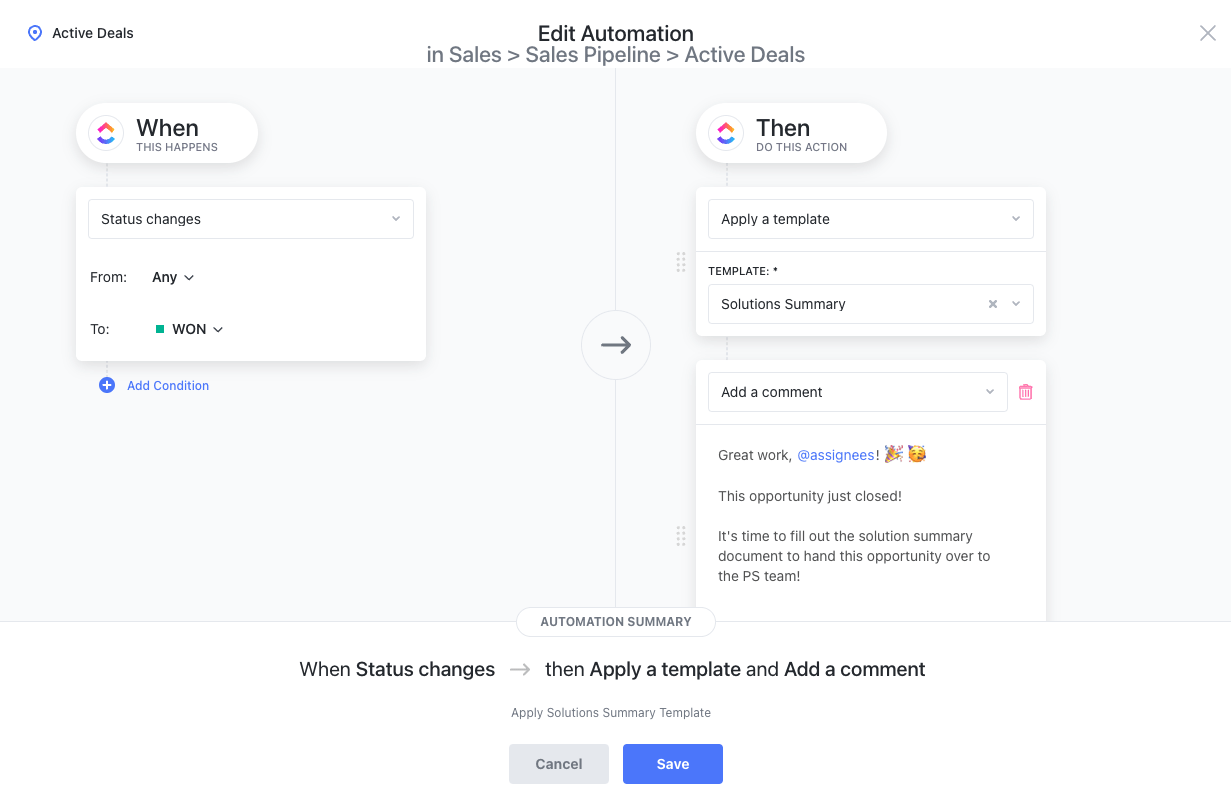
قم بتشغيل النتائج تلقائيًا عند حدوث إجراء ما باستخدام مشغلات التشغيل التلقائي مثل "عند تغير الحالة" لإضافة قالب إلى المهام حتى تتجنب فقدان المعلومات أثناء عمليات تسليم العميل
قم بإعداد تعيينات المهام التلقائية المصممة خصيصًا لكل مرحلة من مراحل العملية الخاصة بك، وابدأ تحديثات الحالة التي يتم تشغيلها بواسطة إجراءات العميل، واضبط الأولويات لتوجيه فريقك إلى المكان الذي يجب أن يركزوا فيه جهودهم بعد ذلك.
4. اتخاذ قرارات عمل أفضل
إن الهدف من إعداد تقارير إدارة علاقات العملاء هو الحصول على رؤى وتحسين عملية اتخاذ القرارات. تأكد من إنشاء خطوة في عملية إعداد تقارير إدارة علاقات العملاء لتقييم الرؤى. انقر فوق المبيعات يجمع كل أنشطة المبيعات في مكان واحد. استخدمه لإنشاء تقارير خط أنابيب والتعاون مع أعضاء الفريق في الصفقات. وتتضمن ميزات إعداد التقارير تقسيم الصوامع وحسابات الإيرادات والنماذج المخصصة لتأهيل العملاء المحتملين. 🙌
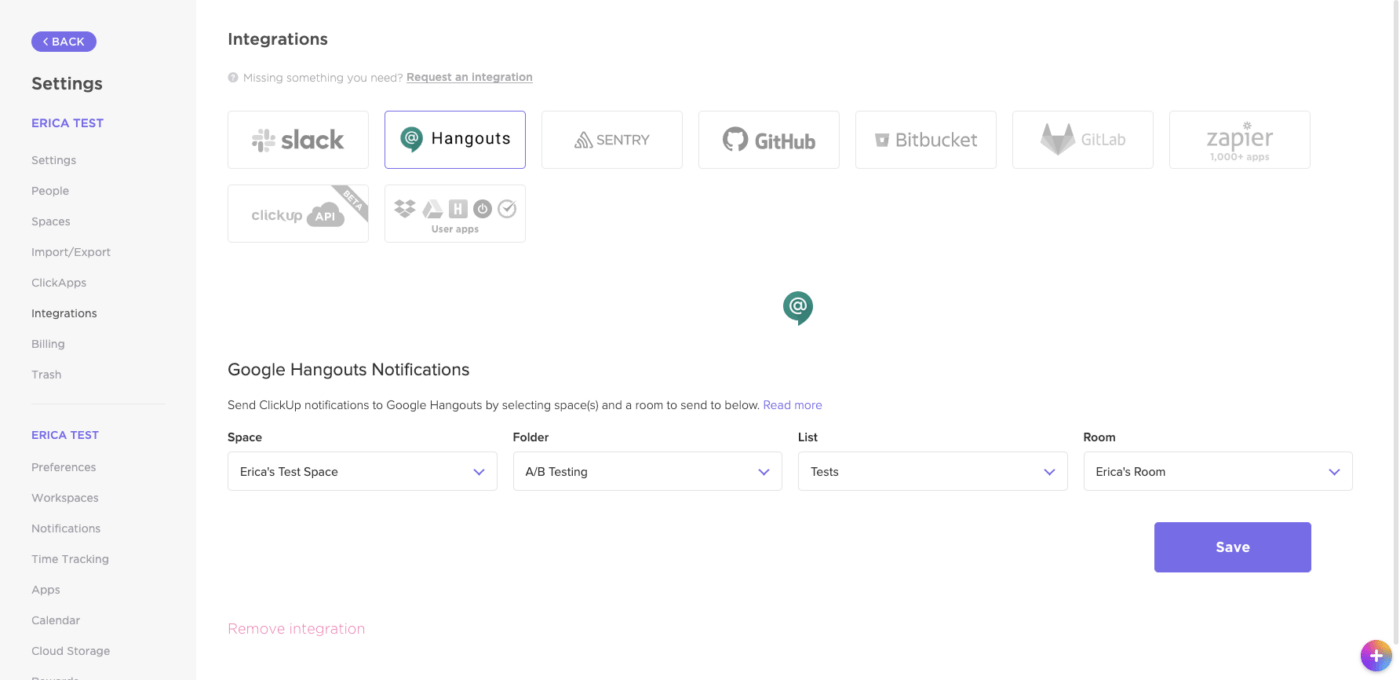
يدعم ClickUp أكثر من 1,000 عملية تكامل بما في ذلك Zoom وGoogle Drive وSlack وMicrosoft Teams لتبسيط سير العمل لديك
عمليات التكامل مع أدوات مثل HubSpot وSlack وHarvest تجعل استخدام أدواتك المفضلة في مكان واحد أسهل من أي وقت مضى. من بداية دورة المبيعات إلى نهايتها، يسهِّل نظام إدارة علاقات العملاء للمبيعات هذا جمع الرؤى وإنشاء التقارير لاتخاذ قرارات أفضل بشأن المبيعات.
5. جدولة الوقت لتحسين العمليات
عندما يتعلق الأمر بذلك، فإن التقارير ببساطة ليست كافية. بينما تقدم تقارير نشاط المبيعات والتنبؤات رؤى رائعة لأعمالك، إلا أنه يجب أن يتبع ذلك اتخاذ إجراءات لدفع أعمالك إلى الأمام حقًا.
استنادًا إلى تقارير إدارة علاقات العملاء الخاصة بك، قم ببناء سير العمل والعمليات لتحديد التحسينات وتنفيذها. ربما تقرر أنك بحاجة إلى خطة تواصل للتواصل مع العملاء

تعيين المهام لحظر أو انتظار بعضها البعض لإنشاء تبعية في ClickUp
ربما تحتاج إلى مزيد من التأييد من الرؤساء الأعلى وتحتاج إلى القيام بما يلي تحليل أصحاب المصلحة لدعم جهود المبيعات الخاصة بك. ربما يتعين عليك معالجة أعباء العمل أو تخصيص الموارد لمساعدة بعض الموظفين. 🛠️
مهما كان الحل، أنشئ مهام سير العمل باستخدام ميزات مثل مهام النقر فوق المهام . قم بتعيين العمل تلقائيًا للموظفين بناءً على رؤى تقارير CRM الخاصة بك. إنشاء التبعيات بحيث يرى أعضاء الفريق المهام التي تعيق العمل على الآخرين.
قم بتقسيم التغييرات المعقدة عن طريق إضافة مهام فرعية وعلامات أولوية للمهام المختلفة. تعاون مع أعضاء الفريق في سلاسل التعليقات، وأضف علامات إلى المهام لجعل إعداد التقارير أسرع.
أمثلة وقوالب تقارير CRM
ألست متأكداً من كيفية إنشاء تقارير CRM أو مدى فائدتها لعملك؟ لقد وضعنا قائمة بأمثلة وقوالب CRM لتوضيح هذا النوع من التقارير بشكل أكبر.
سواءً كنت تدير شركة صغيرة مع عدد قليل من مندوبي المبيعات أو كنت مدير مبيعات في شركة، ستجد رؤى حول فوائد تقارير إدارة علاقات العملاء. 🤩
1. قالب ClickUp CRM
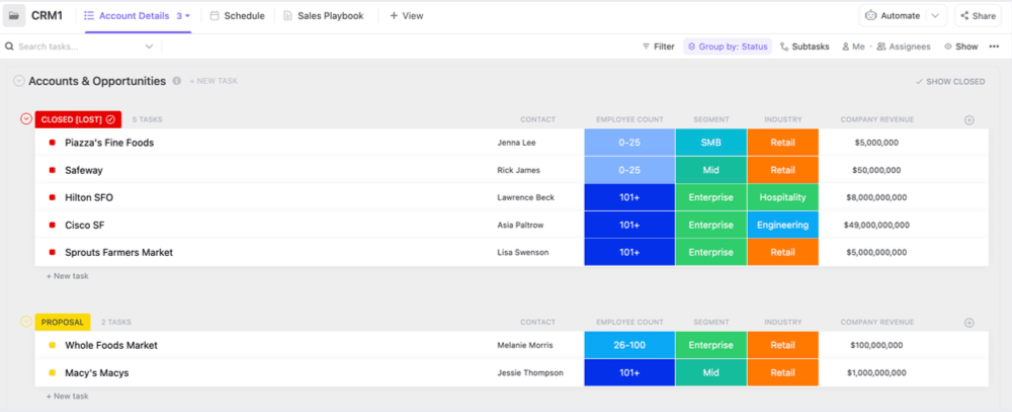
إدارة العملاء وخطوط المبيعات وعناصر الإجراءات والمزيد باستخدام قالب CRM البسيط من ClickUp في عرض القائمة
استخدام قالب إدارة علاقات العملاء من ClickUp لإدارة العملاء المحتملين، وتوليد رؤى حول العلاقات مع العملاء، وإنشاء تقارير عن المبيعات. للبدء، قم بإنشاء قائمة بالحسابات وفرص العملاء.
استخدم الحالات المخصصة لإنشاء تقسيمات في حملات إنشاء العملاء المحتملين. تساعد الحالات مثل "عميل محتمل مؤهل"، و"فائز"، و"مفقود"، و"عرض تجريبي"، و"عرض" في تقسيم العملاء في خط المبيعات.
استخدم طريقة عرض اللوحة البيضاء لإنشاء مخططات انسيابية لتجربة عميلك في قوالب إدارة علاقات العملاء . تُعد طريقة العرض هذه مثالية أيضًا للعصف الذهني للحلول الذهنية لنقاط الضعف. استخدم الرؤى لإنشاء التقارير وجدولة المهام تلقائيًا استنادًا إلى بيانات CRM الخاصة بك.
2. قالب تقرير المبيعات الأسبوعي ClickUp
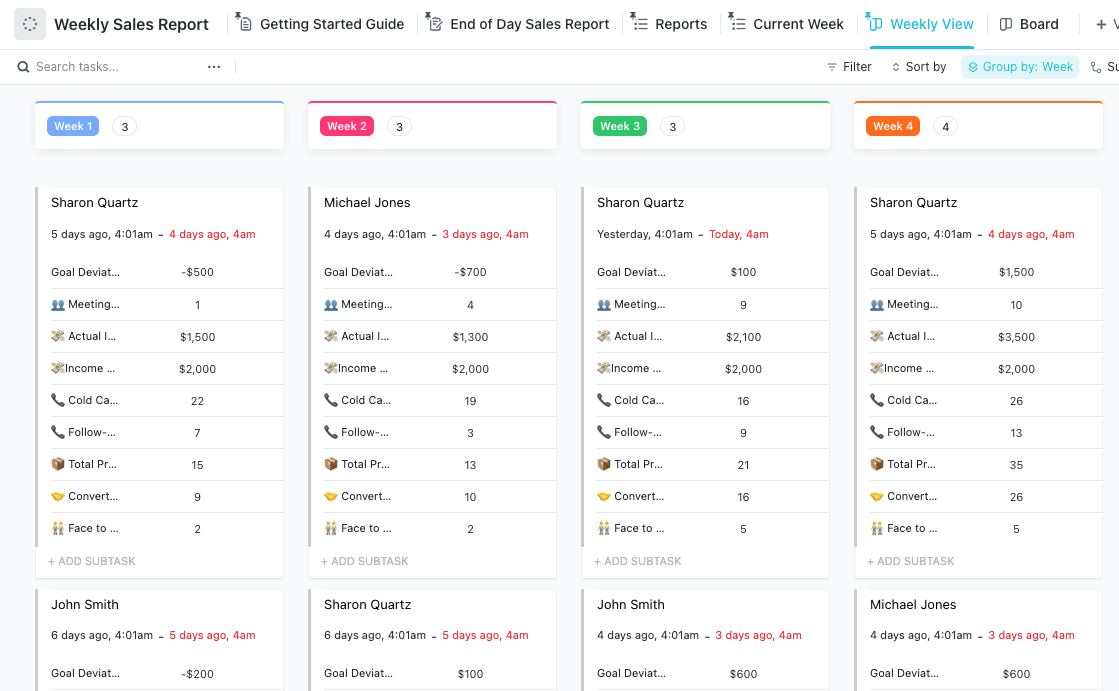
تتبع أداء المبيعات بانتظام باستخدام قالب تقرير المبيعات الأسبوعي من ClickUp
من بين تقارير CRM الأكثر شيوعًا تلك التي تتبع مؤشرات الأداء الرئيسية لفرق المبيعات والتسويق. استخدم قالب تقرير المبيعات الأسبوعي من ClickUp لتتبع مقاييس الأداء وإنشاء رؤى قابلة للتنفيذ على أساس أسبوعي.
للبدء، حدد ما إذا كنت تريد تتبع أداء الموظفين الفرديين أو مقاييس المشروع. قم بتخصيص النموذج لتضمين بيانات عملية المبيعات مثل معلومات الموظفين وتفاصيل مقاييس المشروع المطلوبة. 💡
استخدم طريقة عرض قائمة التقارير لمراقبة الأداء عندما يتعلق الأمر بعدد مكالمات المبيعات وجلسات دردشة دعم العملاء وإجمالي المنتجات المباعة. استخدم طريقة العرض الأسبوعية لتقييم التقدم المحرز على مدار عدة أسابيع أو الغوص في طريقة عرض الأسبوع الحالي للحصول على رؤى حول النجاح هذا الأسبوع.
3. قالب التقرير الشهري لمبيعات ClickUp الشهرية
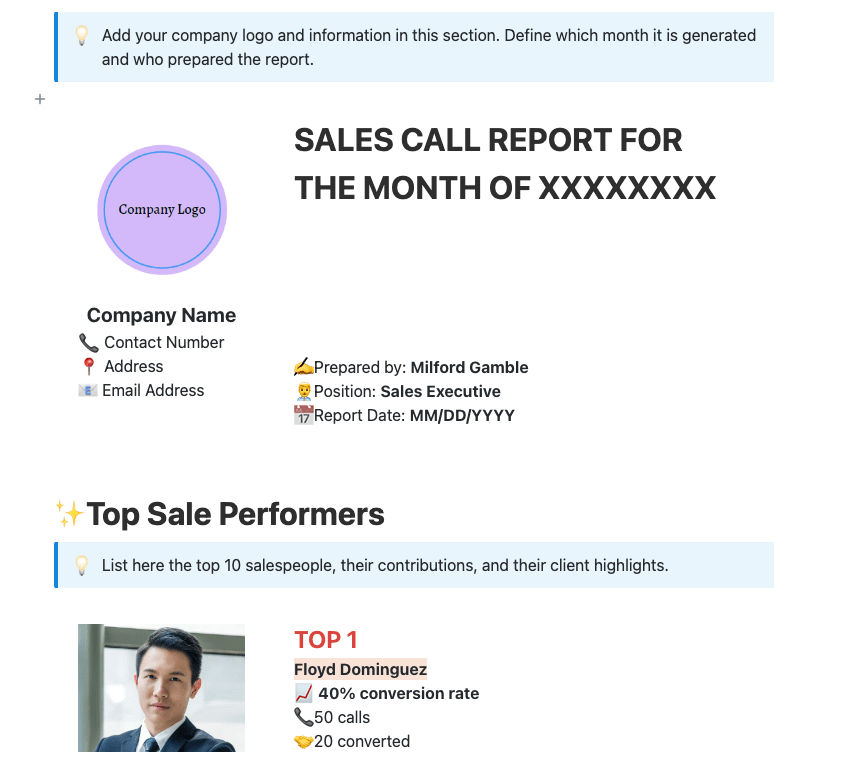
تصور البيانات وسلط الضوء على أفضل أداء لديك باستخدام قالب تقرير المبيعات الشهري من ClickUp
هل تبحث عن تقرير CRM فعال يسلط الضوء على الموظفين في فريقك؟ انتقل إلى نموذج تقرير المبيعات الشهري للمبيعات من ClickUp . يتيح هذا القالب لقادة إدارة المشروع تقييم مدى نجاح كل عضو من أعضاء الفريق في تحقيق أهداف المبيعات الخاصة به.
ابدأ بتقسيم التقرير حسب أعضاء الفريق. استخدم بيانات الموظفين لملء عدد المكالمات ومعدل التحويل وحسابات العملاء التي تعامل معها كل فرد.
قم باستدعاء أصحاب الأداء الأفضل خلال العرض التقديمي لتقارير المبيعات لمكافأة عملهم الجاد. استخدم الحسابات المدمجة لتوليد أرقام معدل التحويل، وناقش طرق رفع هذه الأرقام للشهر التالي.
احصل على رؤى مع ميزات إعداد تقارير CRM من ClickUp
تُعد إدارة علاقات العملاء ضرورية للشركات التي ترغب في فهم احتياجات العملاء وإنشاء تدفقات عمل تحقق أهداف المبيعات بشكل أفضل. من تنبؤات المبيعات إلى تقارير خط الأنابيب وتحليل مصادر العملاء المحتملين، هناك العديد من الطرق للحصول على نظرة أفضل على كيفية تحسين أهداف فريق المبيعات لديك وزيادة التحويلات. اشترك في ClickUp اليوم وابدأ في جمع معلومات العملاء وتوليد الرؤى التي تعزز فعالية المبيعات. استخدم القوالب لإنشاء تقارير في جزء صغير من الوقت، واستفد من ميزات عملية المبيعات لتبسيط سير العمل. 🌻

